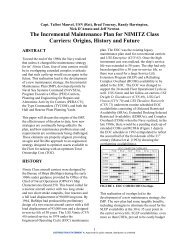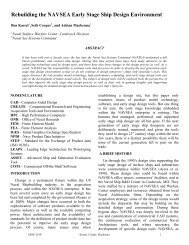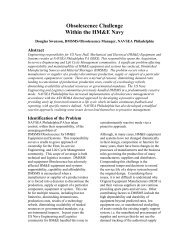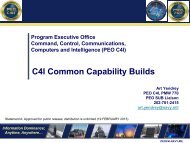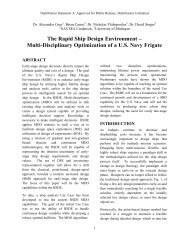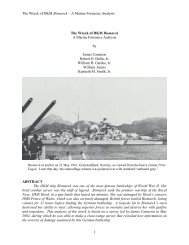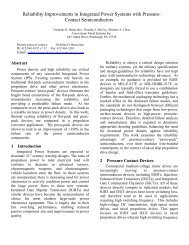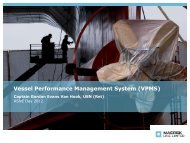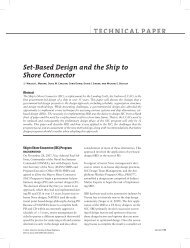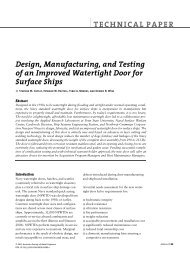Davidson Warfighter Inclusion in System Development final R1
Davidson Warfighter Inclusion in System Development final R1
Davidson Warfighter Inclusion in System Development final R1
You also want an ePaper? Increase the reach of your titles
YUMPU automatically turns print PDFs into web optimized ePapers that Google loves.
1<br />
Dr. Daniel Wallace, NAVSEA Human Factors Eng<strong>in</strong>eer<strong>in</strong>g Technical Warrant Holder;<br />
Mr. Dennis White, NAVSEA Manpower and Personnel Technical Warrant Holder;<br />
Ms. Karole <strong>Davidson</strong>, NSWCDD Human <strong>System</strong>s Integration Program Director<br />
WARFIGHTER INCLUSION IN SYSTEM DEVELOPMENT:<br />
THE OPERATIONAL PERSPECTIVE IN DEFINING DESIGN REQUIREMENTS<br />
ABSTRACT<br />
Human <strong>System</strong>s Integration (HSI) is <strong>in</strong>tegral to any comprehensive system eng<strong>in</strong>eer<strong>in</strong>g process.<br />
HSI is def<strong>in</strong>ed by the International Conference on <strong>System</strong> Eng<strong>in</strong>eer<strong>in</strong>g as an “…<br />
<strong>in</strong>terdiscipl<strong>in</strong>ary technical and management processes for <strong>in</strong>tegrat<strong>in</strong>g human considerations<br />
with<strong>in</strong> and across all system elements; an essential enabler to systems eng<strong>in</strong>eer<strong>in</strong>g practice." But<br />
how does one accomplish this <strong>in</strong>terdiscipl<strong>in</strong>ary <strong>in</strong>tegration? This paper highlights the essential<br />
role of the “<strong>Warfighter</strong>” as an overarch<strong>in</strong>g elicitor and <strong>in</strong>tegrator of system requirements, and<br />
how to effectively exploit this crucial resource.<br />
All complex systems are developed to be used and ma<strong>in</strong>ta<strong>in</strong>ed <strong>in</strong> a specific operational<br />
environment by a tra<strong>in</strong>ed user. It is therefore imperative that the unique operational perspectives<br />
of those users are made part of the design and development process. There are several key<br />
opportunities with<strong>in</strong> the acquisition process where qualified, representative users play a<br />
significant role <strong>in</strong> ref<strong>in</strong><strong>in</strong>g the systems’ requirements and def<strong>in</strong><strong>in</strong>g how the total system will<br />
perform. The active participation of the <strong>Warfighter</strong>s and user community as part of the design<br />
process identifies issues early enough to make a mean<strong>in</strong>gful <strong>in</strong>fluence on design, fosters<br />
<strong>Warfighter</strong> acceptance of the system, reduces the risks associated with <strong>Warfighter</strong> alterations to<br />
system configurations, and validates total system performance us<strong>in</strong>g human <strong>in</strong> the loop<br />
evaluations.<br />
BACKGROUND AND PROBLEM<br />
Human <strong>System</strong>s Integration (HSI) is <strong>in</strong>tegral to any comprehensive system eng<strong>in</strong>eer<strong>in</strong>g process.<br />
HSI is def<strong>in</strong>ed by the International Conference on <strong>System</strong> Eng<strong>in</strong>eer<strong>in</strong>g (INCOSE) as an “…<br />
<strong>in</strong>terdiscipl<strong>in</strong>ary technical and management processes for <strong>in</strong>tegrat<strong>in</strong>g human considerations<br />
with<strong>in</strong> and across all system elements; an essential enabler to systems eng<strong>in</strong>eer<strong>in</strong>g practice."
But how does one accomplish this <strong>in</strong>terdiscipl<strong>in</strong>ary <strong>in</strong>tegration, and why is it even necessary?<br />
With the challenges fac<strong>in</strong>g program managers (PMs) to meet cost and schedule requirements, the<br />
motivation is often to lock down requirements as early as possible. Unfortunately, however, this<br />
restricts the opportunities for the operational experts (the <strong>Warfighter</strong>s) to effectively <strong>in</strong>fluence<br />
the design as it matures. The <strong>Warfighter</strong> cannot always provide a mean<strong>in</strong>gful review of a system<br />
based on the requirements as specified <strong>in</strong> a CDD or other requirements documents; rather, they<br />
need to see an evolv<strong>in</strong>g conceptual design and ases it’s suitability with<strong>in</strong> their operational<br />
m<strong>in</strong>dset.<br />
DIFFERENT PERSPECTIVES OF WARFIGHTERS AND ENGINEERS<br />
There is a fundamental difference <strong>in</strong> the perspectives of the <strong>Warfighter</strong> community and typical<br />
eng<strong>in</strong>eers and system developers. This is an easy truism to which one can pay lip service, but it<br />
is rarely appreciated by the eng<strong>in</strong>eers. We th<strong>in</strong>k we understand all of the system design (or<br />
operational) requirements, because we understand the capability (or performance) requirements,<br />
but these are very different entities.<br />
This is best illustrated by an example. In look<strong>in</strong>g at the detect-to-engage sequence <strong>in</strong> an air<br />
defense scenario, the system capability requirements are well understood: 1) Detect an air threat<br />
of type X at range Y; 2) Determ<strong>in</strong>e the optimal weapon-target pair<strong>in</strong>g; and 3) Determ<strong>in</strong>e best<br />
time to fire salvo to ensure maximum Pk. And if you were to ask an eng<strong>in</strong>eer what the critical<br />
decisions were <strong>in</strong> this scenario, he would likely say, “What is the best weapon to use, and when<br />
should I fire it to achieve the mission success?” And this would be entirely consistent with the<br />
system capabilities perspective. However, the <strong>Warfighter</strong> would have an entirely different<br />
response. To the <strong>Warfighter</strong>, the critical decisions are, “What is the track (ID)?”, “How sure am<br />
I of that ID?”, and “What are the consequences if I am wrong?”This is the operational<br />
perspective.<br />
Clearly, the difference between these perspectives has profound implications for the systems<br />
eng<strong>in</strong>eer<strong>in</strong>g and design of the result<strong>in</strong>g system. The <strong>in</strong>formation displayed for the <strong>Warfighter</strong><br />
must support the operational perspective, and these design requirements can only be captured via<br />
<strong>Warfighter</strong> <strong>in</strong>put.<br />
APPROACH TO A SOLUTION<br />
Includ<strong>in</strong>g <strong>Warfighter</strong>s as part of the Human <strong>System</strong> Integration (HSI) plan early <strong>in</strong> design and<br />
leverag<strong>in</strong>g their operational perspective is help<strong>in</strong>g to br<strong>in</strong>g low cost improvements and solutions<br />
<strong>in</strong>to the Navy. Figure 1 depicts various activities and/or products where human system eng<strong>in</strong>eers<br />
participate <strong>in</strong> the system eng<strong>in</strong>eer<strong>in</strong>g process and <strong>in</strong> each phase the <strong>Warfighter</strong> can, and should,<br />
play a central role.<br />
2
3<br />
HSI <strong>in</strong> the <strong>System</strong>s<br />
Eng<strong>in</strong>eer<strong>in</strong>g Process<br />
Identify Human Performance Component<br />
of Total <strong>System</strong> Capability/Reqmts.<br />
Identify HSI Research Needs<br />
MNS/ORD/SSS Review for HSI Impact<br />
Identify Quality of Life Issues<br />
Discern HSI Metric <strong>Development</strong> Needs<br />
Mission Need<br />
Document all Functions/Tasks<br />
Identify Human / Automation Allocations<br />
Evaluate Technology Integration Feasibility<br />
Analysis of Environmental Conditions<br />
Identify Decision Support Requirements<br />
Requirements<br />
Analysis<br />
Requirements Loop<br />
Verification<br />
Functional<br />
Analysis/<br />
Allocation<br />
Design Loop<br />
<strong>System</strong> Analysis<br />
& Control<br />
Synthesis<br />
<strong>System</strong><br />
Capability<br />
FUNCTIONS<br />
Mann<strong>in</strong>g Optimization<br />
Human Performance Optimization<br />
Workspace / Berth<strong>in</strong>g Design<br />
Decision Support Aid<strong>in</strong>g<br />
Usability Eng<strong>in</strong>eer<strong>in</strong>g<br />
HMI Design<br />
T&E Support<br />
Metric <strong>Development</strong><br />
TOOLS<br />
Model<strong>in</strong>g and Simulation Software<br />
Operator Workload Analysis<br />
Cognitive Task Analysis<br />
Prototype <strong>Development</strong><br />
Usability Test<strong>in</strong>g<br />
Knowledge Management Tools<br />
DOD and Industry HSI Pubs<br />
TRADE STUDY CRITERIA<br />
•Human Performance<br />
•Usability<br />
•Ma<strong>in</strong>ta<strong>in</strong>ability<br />
•Cost<br />
•HMI<br />
•Quality of Life<br />
•Redundancy<br />
Participate <strong>in</strong> IPT’s to<br />
ensure optimization of the<br />
Total <strong>System</strong> by design<strong>in</strong>g to<br />
optimize the Human Element<br />
Figure 1. <strong>System</strong> Eng<strong>in</strong>eer<strong>in</strong>g Process with Human <strong>System</strong> Integration<br />
A system needs to be def<strong>in</strong>ed as the hardware, software, and the people who operate, ma<strong>in</strong>ta<strong>in</strong>,<br />
and make decisions us<strong>in</strong>g it. Total system performance is the <strong>in</strong>tersection of all these pieces of<br />
the system –simply describ<strong>in</strong>g performance parameters for the hardware and software miss the<br />
true <strong>in</strong>tent of the use of the system by the operators/ma<strong>in</strong>ta<strong>in</strong>ers, which must be part of the<br />
calculation. As part of the requirements analysis, a critical decision analysis is important –s<strong>in</strong>ce<br />
the eng<strong>in</strong>eer’s view is quite diferent from the view of the warfighter, as cited above. Therefore,<br />
the warfighter must be <strong>in</strong>volved to validate that the design will <strong>in</strong>deed support his/her mission.<br />
EARLY WARFIGHTER INVOLVEMENT IN FUNCTIONAL ANALYSIS<br />
One essential part of the system eng<strong>in</strong>eer<strong>in</strong>g process is the traditional functional task analysis, or<br />
Top-Down Functional Analysis (TDFA). The TDFA identifies candidate functions or tasks for<br />
automation, elim<strong>in</strong>ation, consolidation, or simplification based upon analysis. The analysis<br />
<strong>in</strong>vestigates which tasks should be performed by the warfighters versus the hardware (equipment)<br />
or software (computer program/automation). “It is the human element that provides us the<br />
flexibility and creativity to deal with the unanticipated threat <strong>in</strong> the unexpected situation that<br />
prevents the enemy from be<strong>in</strong>g able to predict preprogrammed responses.” (Lead<strong>in</strong>g Edge, Vol.
6, Issue 1, pg 8) For example, people are not very good at watch<strong>in</strong>g a screen to determ<strong>in</strong>e when<br />
someth<strong>in</strong>g changes (vigilance). In this case, the software system should alert the operator.<br />
People are, however, great at putt<strong>in</strong>g together a pattern from divergent pieces of data. <strong>Inclusion</strong><br />
of human systems <strong>in</strong>tegration as part of the system eng<strong>in</strong>eer<strong>in</strong>g process reflects the operational<br />
perspective and allows a focus on the <strong>in</strong>teraction of the user with the other elements of the<br />
system where consideration is given to human capabilities and limitations (perceptual, cognitive,<br />
and physical attributes). Some of the benefits of <strong>in</strong>corporat<strong>in</strong>g the user <strong>in</strong>to the system design<br />
process <strong>in</strong>clude design<strong>in</strong>g systems that are optimal for human use and enhance performance by<br />
reduc<strong>in</strong>g error and <strong>in</strong>creas<strong>in</strong>g productivity, enhanc<strong>in</strong>g safety and comfort, <strong>in</strong>creas<strong>in</strong>g levels of<br />
satisfaction, and <strong>in</strong>creas<strong>in</strong>g the warfighter’s ability to learn quickly.<br />
WARFIGHTER INVOLVEMENT IN USABILITY ENGINEERING<br />
A key element <strong>in</strong> warfighter-assisted design is <strong>in</strong> iterative usability eng<strong>in</strong>eer<strong>in</strong>g and assessments.<br />
<strong>System</strong> design concepts should be exposed to the user community very early <strong>in</strong> design –there’s<br />
no need to wait until the system is developed –to ensure that these early concepts conform to an<br />
operational model. Early usability eng<strong>in</strong>eer<strong>in</strong>g can be simply and economically performed with<br />
PowerPo<strong>in</strong>t and user cognitive walk-throughs, and later progress to more functional physical or<br />
software mockups/prototypes. Another element is trade studies, where specific design questions<br />
are answered with a focused test. <strong>Warfighter</strong>s participate <strong>in</strong> the various test events <strong>in</strong> order to<br />
measure their actual performance. The goal is not to simply provide their subjective op<strong>in</strong>ion but<br />
to objectively measure human performance. Us<strong>in</strong>g operationally relevant scenarios with tra<strong>in</strong>ed<br />
and qualified <strong>Warfighter</strong>s to perform the envisioned system’skey requirements can be verified<br />
early <strong>in</strong> the design process when the cost to make changes to the concept or design is m<strong>in</strong>imal.<br />
NEED FOR BALANCE BETWEEN OPERATIONAL AND TECHNICAL CAPABILITY<br />
PERSPECTIVES<br />
Complet<strong>in</strong>g the eng<strong>in</strong>eer<strong>in</strong>g team by <strong>in</strong>clud<strong>in</strong>g the warfighter is a great benefit, however, the<br />
goal is to have a warfighter from the fleet <strong>in</strong>volved periodically throughout the various stages of<br />
development. A warfighter or former warfighter assigned to the program and constantly exposed<br />
to eng<strong>in</strong>eers and the program of <strong>in</strong>terest can heavily <strong>in</strong>fluence the way a sailor or mar<strong>in</strong>e looks at<br />
the environment; eng<strong>in</strong>eers can corrupt a warfighter if they are not careful. The warfighter with<br />
a fresh perspective can provide feedback both on the design under evaluation as well as<br />
potentially new ideas.<br />
On the flip side, one must be careful to make sure that the operational perspective is not confused<br />
with “the way we do th<strong>in</strong>gs today”. It would be a step backwards to simply give the warfighters<br />
a new tool that replicates an old way of do<strong>in</strong>g bus<strong>in</strong>ess; to stay ahead of our adversaries; we must<br />
always push for the greatest technological advantage, so long as we keep the operational<br />
4
perspective. This requires a balanced view that captures operational goals and perspectives<br />
while wedd<strong>in</strong>g the latest technological capabilities. This is true systems eng<strong>in</strong>eer<strong>in</strong>g.<br />
DIFFERENT PERSPECTIVES BETWEEN WARFIGHTERS<br />
One additional consideration is that one or two warfighters cannot adequately capture the full<br />
scope of the operational perspective. Design solutions based upon a small sample of warfighters<br />
will produce a highly idiosyncratic display. A good rule of thumb is to iterate design concepts<br />
early and often with about four or five warfighters <strong>in</strong> each iteration. A few warfighters may<br />
cary over from one iteration to another, so long as “new blood” is brought <strong>in</strong> with each design<br />
cycle.<br />
EXAMPLES<br />
Further sections of this paper address examples of studies and exercises where human<br />
performance data has been collected and how reflect<strong>in</strong>g the operational perspective had an<br />
impact on system designs.<br />
WATCH TURNOVER<br />
The first example exam<strong>in</strong>es a study designed to measure the situation awareness (SA) of an<br />
operator dur<strong>in</strong>g a typical watch turnover. Two versions were compared: the traditional face-toface<br />
watch turnover and an automated turnover software prototype. In order to collect the<br />
required data, the watch turnover was scripted <strong>in</strong> order to ensure that the operator received the<br />
same data no matter whether it was the manual process (speak<strong>in</strong>g with other operators) or the<br />
automated proces (data was provided on the operator’s console).Both the verbal script and the<br />
automated process were developed us<strong>in</strong>g representative warfighters to ensure that the<br />
<strong>in</strong>formation requirements mapped to the operational requirements of the watchstanders. The<br />
situation awareness measures looked at all three levels of situation awareness:<br />
Perception - Do I see/hear/feel it?<br />
Comprehension –Do I understand what I perceive?<br />
Projection –Do I understand the future impacts?<br />
Figure 2 provides the high level results of the experiment where we found that despite a<br />
substantial preference for the automated turnover, objective measures showed no significant<br />
difference <strong>in</strong> actual performance.<br />
5
6<br />
Measure<br />
Performance Measures<br />
Objective Scores<br />
Subjective Self-Rat<strong>in</strong>g:<br />
Understand<strong>in</strong>g (of 100)<br />
Manual<br />
88.0%<br />
57.4<br />
Automated<br />
87.2%<br />
71.8<br />
No statistically significant difference <strong>in</strong><br />
performance<br />
Sailors thought they performed better with<br />
automation, but ….<br />
results show that they did not.<br />
We must measure performance.<br />
Figure 2. Example of Why to Measure Performance<br />
This is just one example of what we often see –the op<strong>in</strong>ion of a person on their performance can<br />
be <strong>in</strong>fluenced by many factors other than their actual performance. Many of us, for example,<br />
th<strong>in</strong>k we will perform better when a new piece of technology is provided to us; however, often<br />
that is not the case and sometimes we even perform worse. When the watchstanders were<br />
objectively measured <strong>in</strong> this case, it was discovered that they had essentially the same<br />
performance, but they subjectively felt that the technology was help<strong>in</strong>g them. The real answer is<br />
a mix of both the objective and the subjective, and <strong>in</strong> reality measur<strong>in</strong>g both and weav<strong>in</strong>g them<br />
together provides the fullest answer.<br />
Poor performance can be due to a number of reasons, <strong>in</strong>clud<strong>in</strong>g poor design, a lack of<br />
understand<strong>in</strong>g of the technology, or <strong>in</strong>sufficient tra<strong>in</strong><strong>in</strong>g of the user. Sometimes the technology<br />
just isn’t a solution for the real problem area. BEFORE we <strong>in</strong>vest heavily <strong>in</strong> technology or<br />
automation, we need to KNOW that it can provide the expected result. In the case above, there<br />
is no performance ga<strong>in</strong>, but there may be a workload or mann<strong>in</strong>g reduction sav<strong>in</strong>gs or a sav<strong>in</strong>gs<br />
<strong>in</strong> the length of time it takes to accomplish the tasks. It is important that we use quantitative<br />
metrics - and not just op<strong>in</strong>ions - to guide decisions on where to spend precious DoD dollars.
CONCEPT OF OPERATIONS EXERCISES (COOPEXS)<br />
The next example deals with a variety of concepts of operation exercises conducted by a jo<strong>in</strong>t<br />
government and <strong>in</strong>dustry team for a new ship design. The Navy (government) technical team <strong>in</strong><br />
conjunction with the <strong>in</strong>dustry design agent conducted a Concept of Operations exercise<br />
(COOPEX) <strong>in</strong> January 2005. The program had developed a robust visual prototype of the bridge<br />
(operationally manned space) which had been reviewed by warfighters; however, the team<br />
decided to proceed with a low cost physical mock-up of the space. The experiment <strong>in</strong>volved<br />
three typical operational scenarios –underway replenishment, harbor transit and formation<br />
steam<strong>in</strong>g. The mock-up was a low-cost full-scale version of the bridge made from form-core and<br />
duct tape, designed to only look at some basic issues. The experiment was critical s<strong>in</strong>ce the<br />
bridge design is radically different than other ship classes that exist today. The warfighters<br />
<strong>in</strong>volved were all qualified to stand watch on exist<strong>in</strong>g surface ships’ bridges today, and reflected<br />
the operational perspective. The results of the experiment identified a number of design issues<br />
with some of them hav<strong>in</strong>g impact on the structural design of the bridge. The experiment<br />
provided a cost avoidance many, many times larger than the cost of the relatively simple mockup<br />
costs. The success of this experiment led to another mock-up of the helicopter control station<br />
which identified multiple usability issues, an egress solution for a safety issue as well as just<br />
simple errors <strong>in</strong> the ship draw<strong>in</strong>gs.<br />
SUMMARY<br />
As demonstrated by the various examples provided as well as other Navy experience, warfighter<br />
<strong>in</strong>teraction allows the <strong>System</strong>s Eng<strong>in</strong>eer<strong>in</strong>g Team to elicit operational requirements and measure<br />
performance related to: physical layout, communication requirements, team composition and<br />
arrangement, conceptual functional and <strong>in</strong>formation requirements, display <strong>in</strong>formation<br />
requirements and decision support aids, access and egress, perceived procedural, cultural, and<br />
policy issues associated with concepts, and mann<strong>in</strong>g concepts as applied to various conditions of<br />
read<strong>in</strong>ess and special evolutions. This <strong>in</strong>teraction is not simply user op<strong>in</strong>ion, but a measured,<br />
formal elicitation of both op<strong>in</strong>ion and human performance metrics conducted and analyzed by<br />
HSI eng<strong>in</strong>eers.<br />
The bottom l<strong>in</strong>e is best summed up by NAVSEA’s <strong>System</strong>s Eng<strong>in</strong>eer<strong>in</strong>g and Human <strong>System</strong>s<br />
Integration Director, Ms. Trish Hamburger, “The real key for us is that human systems<br />
<strong>in</strong>tegration <strong>in</strong> all of its dimensions is a key part of systems eng<strong>in</strong>eer<strong>in</strong>g, and it has to be<br />
embedded <strong>in</strong> it at the very beg<strong>in</strong>n<strong>in</strong>g, dur<strong>in</strong>g the analysis of alternatives, and the <strong>in</strong>itial concepts,<br />
and the <strong>in</strong>itial requirements, and then measured throughout the process <strong>in</strong> order to ensure that our<br />
systems are designed to optimize warfighter performance but, more importantly, to optimize total<br />
system performance to actually meet the mission capability. And the warfight<strong>in</strong>g community –<br />
for us, our Sailors and Mar<strong>in</strong>es –is an esential part of mak<strong>in</strong>g that happen.” In conclusion, by<br />
7
employ<strong>in</strong>g a total systems eng<strong>in</strong>eer<strong>in</strong>g approach that <strong>in</strong>volves not only the hardware and<br />
software but also the people, total systems performance can be achieved.<br />
8
Dr. Daniel Wallace<br />
Naval Surface Warfare Center Dahlgren Division<br />
18444 Frontage Road<br />
Suite 327<br />
Dahlgren, VA 22448-5161<br />
Phone 540-653-8097<br />
Fax 540-653-2514<br />
Daniel.f.wallace@navy.mil<br />
Mr. Dennis White<br />
Naval Surface Warfare Center Dahlgren Division<br />
18444 Frontage Road<br />
Suite 327<br />
Dahlgren, VA 22448-5161<br />
Phone 540-653-2133<br />
Fax 540-653-2514<br />
Dennis.white3@navy.mil<br />
Ms. Karole <strong>Davidson</strong><br />
Naval Surface Warfare Center Dahlgren Division<br />
18444 Frontage Road<br />
Suite 327<br />
Dahlgren, VA 22448-5161<br />
Phone 540-653-1241<br />
Fax 540-653-3607<br />
Karole.davidson@navy.mil<br />
9
Dr. Daniel Wallace is a Senior Scientist at the Naval Surface Warfare Center,Dahlgren Division.<br />
Dr. Wallace is the Human Factors Eng<strong>in</strong>eer<strong>in</strong>g Technical Warrant Holder for NAVSEA. He has<br />
led development of human eng<strong>in</strong>eer<strong>in</strong>g methodologies that articulate processes and procedures to<br />
be followed <strong>in</strong> execut<strong>in</strong>g standard human eng<strong>in</strong>eer<strong>in</strong>g practice with<strong>in</strong> systems eng<strong>in</strong>eer<strong>in</strong>g. He is<br />
active <strong>in</strong> execut<strong>in</strong>g the eng<strong>in</strong>eer<strong>in</strong>g rigor of this human eng<strong>in</strong>eer<strong>in</strong>g practice <strong>in</strong> a large number of<br />
programs, as well as gett<strong>in</strong>g this message out to the eng<strong>in</strong>eer<strong>in</strong>g community through <strong>in</strong>vited<br />
brief<strong>in</strong>gs and <strong>in</strong> <strong>in</strong>ternational forums. Internationally, he is the U. S. National Lead for a panel on<br />
maritime human factors under The Technical Cooperation Program (TTCP) and is the chair of<br />
the Human <strong>System</strong>s Integration Work<strong>in</strong>g Group under the ABCANZ 99-02 panel.<br />
Mr. Dennis White is the head of the Naval Surface Warfare Center Dahlgren’s Human <strong>System</strong>s<br />
Integration (HSI) branch, lead<strong>in</strong>g a team of Human <strong>System</strong>s Eng<strong>in</strong>eers that address HSI <strong>in</strong><br />
numerous Navy, Jo<strong>in</strong>t and DoD system developments. The Dahlgren HSI team’sassets <strong>in</strong>clude<br />
the Human Performance Laboratory (HPL) where systems and team concepts are developed and<br />
evaluated for warfighter performance effectiveness <strong>in</strong> an operationally relevant environment. Mr.<br />
White is the Manpower and Personnel Technical Warrant Holder for NAVSEA with extensive<br />
experience <strong>in</strong> US Navy manpower model<strong>in</strong>g and simulation. He is a former Surface Warfare<br />
Oficer and ‘Mustang’ –achiev<strong>in</strong>g a commission though the Navy Enlisted Commission<strong>in</strong>g<br />
program.<br />
Ms. Karole <strong>Davidson</strong> is the Human <strong>System</strong>s Integration program director with Naval Surface<br />
Warfare Center <strong>in</strong> Dahlgren, Virg<strong>in</strong>ia, where she has spent the last five years work<strong>in</strong>g on various<br />
projects through the Naval Surface Warfare Center and other Navy customers. She currently<br />
supports the Naval Sea <strong>System</strong>s Command's Human <strong>System</strong>s Eng<strong>in</strong>eer<strong>in</strong>g Directorate, NAVSEA<br />
05H and various PEOs <strong>in</strong> the areas of policy, certification, and acquisition program support.<br />
10



